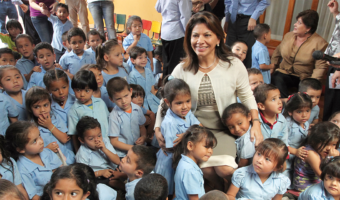Social issues are complex, with multiple, interdependent causes that exceed the responsibility of any single sector or actor. Understanding this, Colombia has faced its significant social challenges in recent decades by creating inter- agency coordination mechanisms that favour comprehensive approaches and connected actions. Little by little, these mechanisms have been able to go beyond coordinating sector efforts to develop unified management based on their own holistic perspectives.
The National System of Comprehensive Care for the Displaced Population (SNAIPD) is one example. As a result of a judgement by the country’s Constitutional Court on rights violations in forced displacement1, public policy was strengthened. This did not give more rights to victims, but improved the enforceability of their existing rights. Maximising the efficacy of state prevention actions, emergency humanitarian care, return, consolidation and socioeconomic stabilisation mitigated the adverse effects on this population.
The country has used a similar inter-sectoral mechanism on poverty reduction, ‘Red Unidos’ (United Network). Since 2006, it has facilitated the coordination of different entities to tackle the multiple dimensions of extreme poverty through a comprehensive response to improve living conditions and protect rights.
Until recently, policies addressing childhood in Colombia concentrated on preventing exclusion and violation of rights, and eliminating unjust circumstances that impact the full enjoyment of rights. This trend changed with the State Policy for the Comprehensive Development of Early Childhood ‘De Cero A Siempre’ (‘From Zero to Forever’), under the responsibility of the Inter-sectoral Commission of Early Childhood (CIPI), which coordinates different sectors to generate the conditions for every child to achieve their potential.
Comprehensiveness is central to the Policy. Reductionist views of human beings, their realities and circumstances are easy to understand, but they fragment knowledge. New narratives need to make clear the multidimensional and systematic nature of the social support people need. This can form the basis of an inter-sectoral strategy for coordination between actors that maximises their harmonious synchronisation.
The State Policy covers actions related to care and upbringing, health, food and nutrition, primary education, recreation, and the participation in and exercise of citizenship. It aims to protect children’s dignity, strengthen families and their links with those responsible for their care, and promote their self-determination and the construction of a sense of personal and collective identity in diversity.
Progress on poverty indicators
The sustained effort in comprehensive care during early childhood is demonstrated by improvements in measures of different dimensions of poverty since 2011. The Multidimensional Poverty Index (IPM) considers 15 variables grouped into five categories:
- Educational conditions (low educational achievement and illiteracy)
- Conditions of children and adolescents (truancy, falling behind in school, access barriers to services for early childhood care, child labour)
- Employment status of household members
- Health access and insurance, and
- Housing conditions.
The IPM uses the household as the level of analysis: if one member suffers some shortage, this affects the whole home. For example, households are considered to fall short on the variable of access to childcare if at least one child aged 5 or under does not have access to comprehensive early childhood care services, even if other children in the household do have access. All those who constitute a household are considered multi-dimensionally poor if it falls short on at least five of the 15 variables. Multidimensional poverty decreased from 30.4% in 2010 to 19.6% in 2018 (National Statistics Administration Department (DANE), online).
Six of the 15 variables relate to children, adolescents and education. This means that policy actions in these areas have an essential role in poverty reduction. With De Cero a Siempre, Colombia increased the coverage of quality services for early childhood care from 566,429 children in 2010 to 1.1 million in 2018 (National Planning Department (DNP), 2010, 2019). The proportion of children attending the transition grade – a year of preschool to prepare for primary school – went from 61.8% to 64.06%. (Net coverage across all levels of the educational system increased from 89.8% to 92.3% during the same period.) These achievements reduced the number of households falling short on the IPM variable for barriers to early childhood care services from 11.8% in 2010 to 9.3% in 2018.
Comprehensive care actions also reduced chronic malnutrition, from 13.2% in 2010 to 10.8% in 2015, through nutritional monitoring, delivery of quality food, promotion of growth and development check-ups, and promotion of vaccinations (Ministry of Health, 2015). In addition, care for pregnant women through antenatal check-ups, adequate care during birth, promotion of breastfeeding and counselling in early education programmes all helped reduce mortality: maternal mortality from 71.9 per 100,000 live births in 2010 to 44 in 2018 (Instituto Nacional de Salud, 2019); infant mortality from 12.8 per 1000 live births in 2010 to 10.7 in 2017; and under-5 mortality from 15.7 to 13 over the same period (Ministry of Health, 2019).2
As part of the Policy’s inter-sectoral efforts, the government’s Families in Action programme was redesigned in 2011 to subsidise the enrolment of children in the transition grade. It is hoped that in the medium term this will reduce the number of children who enter the educational system late. Evidence among other age groups shows that the programme’s cash transfers have direct effects on educational indicators: for example, the probability of dropping out was reduced by 0.8% in municipal centres. Positive effects in secondary education grades were demonstrated, with an increase in the probability of enrolment of about 16% in urban areas and 23% in rural areas and a reduction in child labour.
Upcoming challenges
Although the results indicate that the country is on the right path, there are three significant challenges for public policy in the coming years.
- Care for the migrant population
With growing migration from Venezuela, Colombia needs to care for more migrant children and those who are born to migrants in Colombia. The challenges involve almost all sectors: the healthcare system needs to provide antenatal check-ups, vaccinations, and urgent care; the Colombian Institute of Family Welfare (ICBF) must ensure comprehensive early childhood care services for an estimated 68,340 children; and the educational sector needs to guarantee care for an estimated 314,736 students.
- Closing urban–rural gaps
Against almost all indicators, the differences between large cities and rural areas are substantial, not only in the coverage but especially in the quality of services. These disparities are even greater in areas affected by the armed
conflict. The country’s geographical characteristics make it hard and expensive to implement public policies in rural areas – but to advance social equality this is an urgent issue to tackle.
- Adaptation in light of the Covid-19 pandemic
The educational system had to adapt quickly to deliver services through alternative learning methodologies at home, rising to new challenges in ensuring access, quality and the participation of families. In public administration, we need to be creative so that children can continue learning adequately. The decisions taken today will affect people’s lives for a long time.
When entities specialise in their mission, inter-sectoral work becomes more necessary. It is the most efficient way to address major challenges and promote well-being for all.
All references can be found in the PDF version of this article.
1 Constitutional Court, Ruling T-025 dated 2004.
2This contributes to UN Sustainable Development Goal 3, to ensure healthy lives and promote well-being for all at all ages, whose main objective is to reduce maternal mortality and put an end to avoidable deaths in children under 5 years of age.



